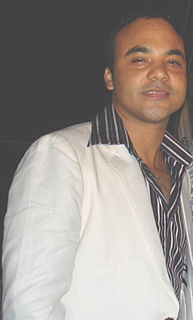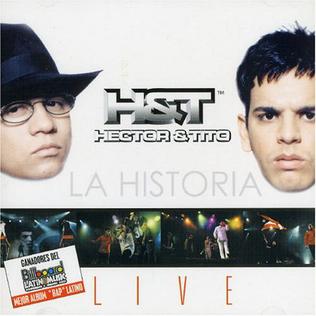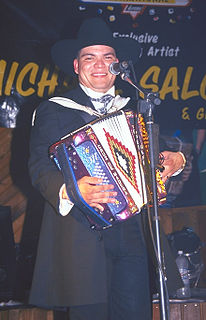Biography
Perez was born to Carmen Perez and Arcadio Astacio on December 26, 1946, in Guayabo Dulce, a province of Hato Mayor del Rey, Dominican Republic. [2] As a young boy, Perez would fish and swim in a local river, later inspiring him to write songs about his experience of nature. Perez began to work at the age of fourteen as a sugar cane cutter, earning only 35 cents per trip. It was at this time that his sister Leonidas "Morena" Rondon Perez moved to Placer Bonito at No. 34 Maria Quirino St. in neighboring province San Pedro de Macorís. Nine years later, Perez decided to move to San Pedro de Macorís, where he made contact with local musicians Negro Sánchez, Suri Domínguez, Julito Reyes, and Ramón Marrero. Perez would meet them at Sánchez's home in Loma del Cochero, where they would play and compose songs under a limoncillo tree. During these years, Perez recorded his first and second albums, "Sin Rumbo" and "Entre Copa y Copa", which did not succeed.

Hato Mayor del Rey is the capital of Hato Mayor Province, Dominican Republic. It is bordered on the North by the municipalities of El Valle and Sabana de la Mar, on the South by the San Pedro de Macorís Province, on the East by the El Seibo Province and on the West by the municipality of Bayaguana, Monte Plata. It is located 27 kilometers from the San Pedro de Macorís Province and 110 kilometers from the capital city of Santo Domingo. Hato Mayor del Rey has a population of 70,141 inhabitants, and is divided into three municipal districts: Yerba Buena, Guayabo Dulce and Mata Palacio.

The Dominican Republic is a country located on the island of Hispaniola in the Greater Antilles archipelago of the Caribbean region. It occupies the eastern five-eighths of the island, which it shares with the nation of Haiti, making Hispaniola one of only two Caribbean islands, along with Saint Martin, that are shared by two sovereign states. The Dominican Republic is the second-largest Caribbean nation by area at 48,671 square kilometers (18,792 sq mi), and third by population with approximately 10,299,000 people, of whom approximately three million live in the metropolitan area of Santo Domingo, the capital city.

San Pedro de Macorís is a municipality (municipio) in the Dominican Republic and the capital of the San Pedro de Macorís province in the south-eastern region of the country; it is among the 10 largest cities of the Dominican Republic. The city has approximately 195,000 inhabitants, when including the metro area. As a provincial capital, it houses the Universidad Central del Este university.
In the 70's, Christopher Acosta formed the group "Los Dominicanos del Ritmo", later known as "Los Cibernéticos", which Perez joined. The group would meet at "El 28", an entertainment center located on the street 30 de marzo next to the sports complex. There Perez met Cristóbal Acosta, Ángel Guerrero, Sijo Osoria, José Ventura, Juan Bautista, Tony Santos, Pepillo the owner of "El 28", and others.
After Perez's first hit, "Aclamando El Licor", his songs were widely broadcast. He was supported by broadcasters Gregorio Justiniano in Radio Mar, Michel and Domingo de los Santos in Radio Dial, and Edwin Emmanuel (el bravo) in Radio Oriente. Perez and Los Cibernéticos hosted well-attended events in the Apollo Disco Club. Marino popularized many songs, including "El Trago de Olvidar", "De Taberna en Taberna", and "La Espero Bebiendo". Marino was loved and acclaimed by many, but his enjoyment of parties, women, and liquor led to a poor reputation. He was not received well in some parts of society and drew inspiration from this criticism to write "Que Sigan Criticando que Yo Sigo Gozando". Due to his talent, Perez could find inspiration in sayings, holidays, stories, and even tragic events. A musician who was at the height of his career, Wilfrido Vargas, found some of Perez's hits and adapted them, resulting in a resounding international success. However, despite the success of his albums, Perez lived his life in poverty as bachateros were underpaid.
In 1991, Marino was admitted to San Pedro Medical Center for liver cirrhosis, staying there briefly before returning to his family. He died two days later at his home on Romana Gonzales St. in the neighborhood of Mejico No. 145 in San Pedro de Macoris, where he lived with his mother, sister, and two daughters Raysa Perez and Johanna Veronica.
Perez was known as one of the most authentic representatives of bachata. Just minutes after the Radio Dial news broadcast of his death, the city of San Pedro de Macoris became a sea of tears and grief for such a huge loss. His funeral is remembered for being one of the most emotional and well attended events in the history of the city. When the funeral motorcade arrived at the cemetery next to Santa Fe, the tail was still in the park Duarte. Marino Perez's songs still live in all stations across the country even with the passage of years after his death. The public continues to buy his records, and he is remembered as a musical icon for his career in folk art. [1]





